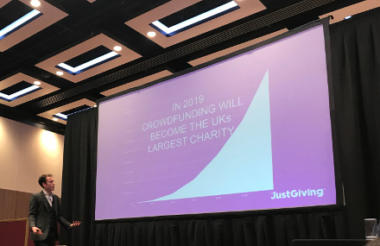Charities should not see crowdfunding as a threat and instead see it as a way to introduce people to generosity, JustGiving’s chief marketing officer said at Fundraising Live last week.
Charles Wells was speaking at Civil Society Media’s fourth annual fundraising conference about 'The evolution of giving' where he told charities that they shouldn’t be fearful of crowdfunding, and instead view it as a way to grow their audience. He said that the fundraising platform was working on ways to encourage crowdfunding audiences to become regular charity donors.
He said that if JustGiving takes the last two years of data and extrapolates it forwards, crowdfunding will be bigger than any individual charity in the UK by next year.
But Wells said that he is “not sure crowdfunding is entirely cannibalising the sector”.
He said that from looking at data from both the Grenfell Tower and Manchester terrorist attack campaigns, crowdfunding kicked in well before charitable donations, but once charity donations had started it did not impact the growth of crowdfunding campaigns.
He said that this indicates that different audiences are donating to each type of appeal.
“What this shows me is that although you might see crowdfunding as a threat, it might actually be a really interesting way of introducing people to generosity,” he said.
Wells said that charities need to start looking at crowdfunding as a method and suggested that they should be thinking abuot how they can start behaving more like crowdfunders.
He said: “You can think of crowdfunding as a new donor base. And you can use crowdfunding as a method of getting people into generosity.”
Analysing JustGiving's data
He said that JustGiving wants to look at how it can actively promote the link between crowdfunding and donating to charity. They want to do this by understanding what individuals care about and start introducing them to causes they might get involved in.
JustGiving wants to look at how it can actively promote the link between crowdfunding and donating to charity, Wells told delegates. He said that they want to do this by understanding what individuals care about and start introducing them to causes they might get involved in.
He said that there is a pool of people on JustGiving that are not affiliated with any charity, and that JustGiving wants to make sure it can find a charity.
Wells said that over the last few years JustGiving has been looking at the different behaviours of people who donate to a crowdfunding page to those who donate to a charity page, and it has found that there are lots of things that people care about that are not charities and that people want to give to.
Charities should behave like crowdfunders
Wells told delegates that charities should behave more like crowdfunders, and one way to do this is to use JustGiving Campaigns. The platform launched last year and allows charities to do this, by raising money for one particular cause. He said it was also designed to help charities “find new audiences”.
He mentioned the example of a few local RSPCA groups who had used this platform to crowdfund for a particular animal that needed assistance.
He said charities should think about launching “more smaller calls for action” and “more tangible impacts”.
Donor behaviour has changed
Wells told the room of fundraisers that as a sector “we sell a warm, fuzzy feeling that people get in exchange for their donation”.
But, he said: “Over last few years we've seen donor behaviour change. Once people change their behaviour and find a different way to get the same feeling, that is easier and more accessible, they don’t change back. Has anyone tried to turn your TomTom off and get your map out recently? It is really hard work.”
Wells said that JustGiving can see that people are most likely to give at 9.30pm during the advert break on the TV show they are watching through their phones, and that this is when people are looking at their friends at what their friends are up to.
He said that this has changed from three years ago when people were most likely to give on their desktops at work, just after their lunch break.
But because of this, giving needs to be quick and easy.
He said that JustGiving holds eight million people’s credit cards so when they go onto JustGiving they just have to hit the button once, click the gift aid form and add the amount they want to give, and it is done. As a result it has a 90 per cent conversion rate.
He added: “You’ve got to get them before the kettle has boiled and the programme has started, so we don’t have long.”
|
Don't miss












